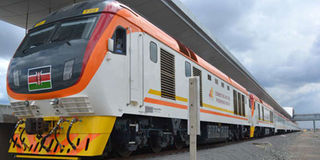Cartels, interests almost killed SGR project: official

A new train at the Nairobi terminus on May 29, 2017.
What you need to know:
- The railway was conceived during the Grand Coalition government of President Mwai Kibaki and Prime Minister Raila Odinga sometime in 2009, to be a part of the Vision 2030.
- Gen (rtd) Jeremiah Kianga, who has chaired the Corporation since 2011 when the SGR project was in its nascent phase, says he constantly fought with “a diversity of interests” to ensure the project ran its course.
Cartels and interest groups nearly crippled the construction of the standard gauge railway (SGR), the chairman of Kenya Railway Corporation claimed as the country launched the first train on the new track.
Gen (rtd) Jeremiah Kianga, who has chaired the corporation since 2011 when the SGR project was in its nascent phase, says he constantly fought with “a diversity of interests” to ensure the project ran its course.
“I had thought that with my service of nearly 40 years (in the military), I was well prepared for any assignment in public service,” he told a gathering during the launch of the first cargo train on the SGR in Mombasa.
“The reason this was challenging was that there was the multiplicity of players and the diversity of interests. And some were pulling in directions that were not helpful,” he added.
Gen (rtd) Kianga had retired from the military in August 2011 to chair the KRC at a time firms were competing for the lucrative tender to build and operate the proposed railway.
KICK-BACKS
The railway was conceived during the Grand Coalition government of President Mwai Kibaki and Prime Minister Raila Odinga sometime in 2009, to be a part of the Vision 2030.
But it wasn’t until President Uhuru Kenyatta came to power that a deal was signed in August 2014 for a financial loan from China Exim Bank, and the railway to be constructed by China Road and Bridge Corporation.
That kicked off a series of challenges from environmental groups, who opposed the railway passing through national parks in Tsavo and Nairobi, land owners who demanded to be compensated, and business operatives who challenged the award of the tender.
The National Assembly's Transport Committee, chaired by Maina Kamanda, would eventually give the project the green light but not without accusations that the MPs had pocketed money to look the other way.
In fact, some economists challenged the feasibility of the project and whether the new railway was needed at all.
PARK STALEMATE
“We have had to go through very many challenges - the court cases, the environmental issues and the political issues surrounding this project,” said Deputy President William Ruto at the launch.
“This is a very proud moment for you (President), for the Jubilee administration and the people of Kenya. It shows the result to deliver results despite the challenges,” he argued.
But environmentalists continued to fight the project even when construction had started.
In Nairobi, they opposed the line passing through Nairobi National Park and called on the National Environmental Management Authority (Nema) not to approve it.
Nema would, in January this year, allow the track to pass through the park, with conditions that it should not disrupt the routes animals use.
MIDDLE INCOME ECONOMY
But even on the launch of the first train, government officials still had to answer environmental questions.
“We have tried very much to ensure that we do not obstruct the natural passage of animals…some areas are elevated,” President Uhuru Kenyatta told reporters aboard the train when asked about its impact on the Tsavo.
“I do not think there is going to be any disruption whatsoever,” he said.
As part of Vision 2030, the railway was supposed to fit into an ambition to have sufficient infrastructure necessary to make Kenya a middle-income economy by 2030.
That meant roads, railways, ports, power generation plants and related facilities necessary to power the envisioned industries.
SGR TARGETS
But what targets have been set for the new railway? The President argued the track is only a segment of what is needed and there will be no immediate export goals to it until the entire project scheme is completed.
“We haven’t set any targets because we still got to go and move towards the industrial parks…These are what will determine the volume of exports as we move down the path to industrialisation,” he said.
“That is why I keep talking about the industrial parks that we need to develop; the dry dock that we need to develop in Voi; there is another cargo handling park that we need to develop in Athi River and the industrial parks that we need to build; one in Voi, one also in Athi River, Machakos, and we need to do another one also in Naivasha and ultimately another one in Kisumu,” he said.
“Let us abandon divisive politics and build Kenya together. Whatever your political belief, whoever you support, today we should be together. We should celebrate together,” he added.
The port of Mombasa, where the ceremony was held, and the railway also represent Kenya’s existence on the international stage.
JAPANESE LOAN
While the latter is a product of a loan from China, the port is being expanded with a loan from the Japanese, who have recently been fighting with Beijing for a stake in Africa.
Last year, Kenya launched a new container terminal at the port built with a $297 million loan from the Japan International Corporation Agency (JICA).
It can handle 550,000 containers a year, improving the port’s capacity to 1.6 million containers annually. Kenya is to repay the loan in 40 years.
Japan announced it will spend a further $500 million on the port, in its second phase of expansion that involves dredging out the harbour and creating new berths for ships.




